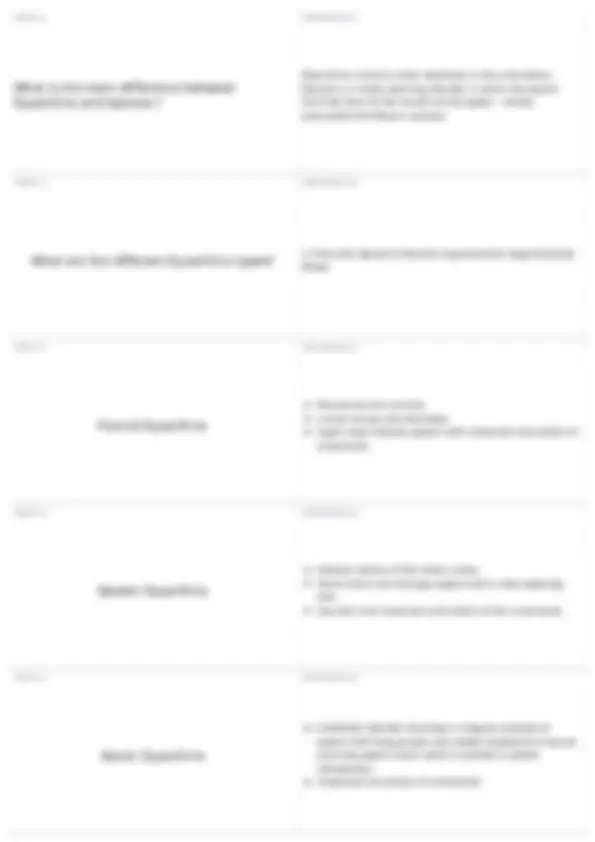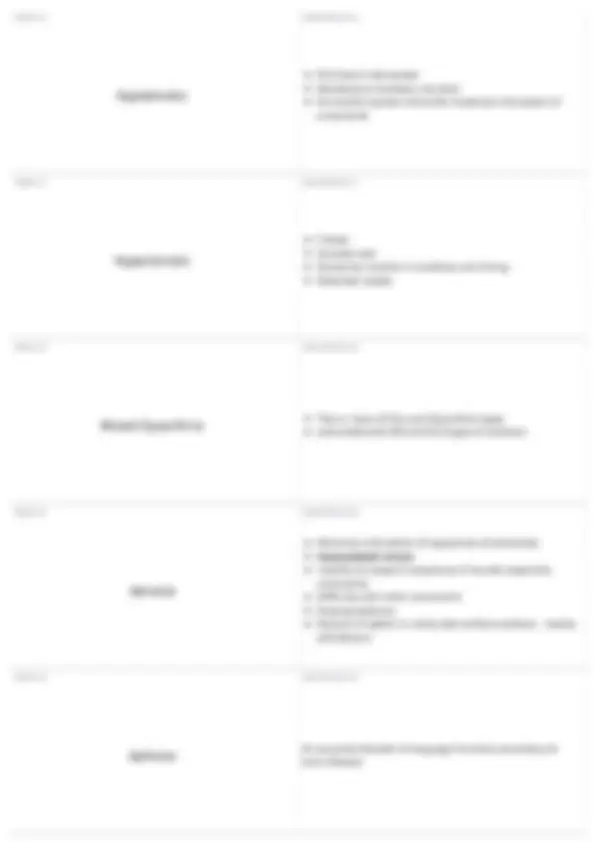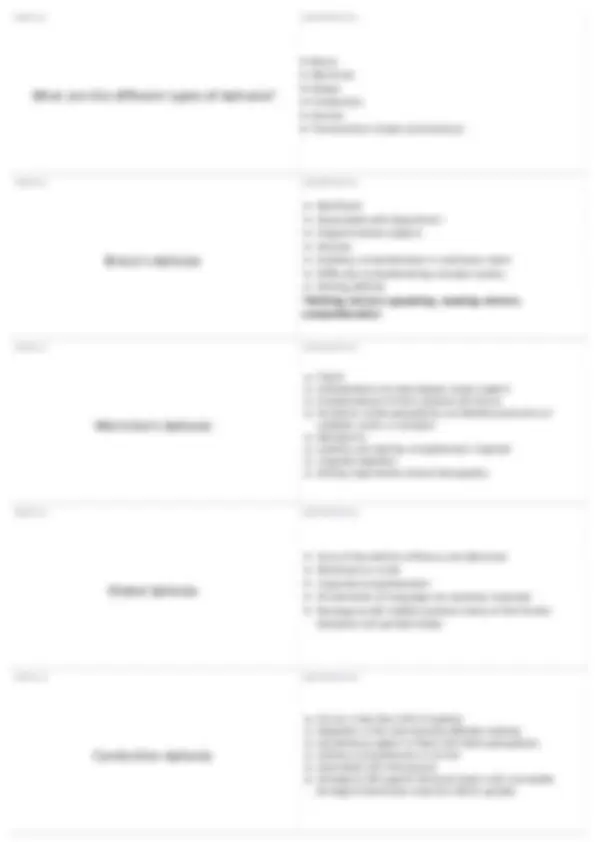






Study with the several resources on Docsity

Earn points by helping other students or get them with a premium plan


Prepare for your exams
Study with the several resources on Docsity

Earn points to download
Earn points by helping other students or get them with a premium plan
Community
Ask the community for help and clear up your study doubts
Discover the best universities in your country according to Docsity users
Free resources
Download our free guides on studying techniques, anxiety management strategies, and thesis advice from Docsity tutors
Definitions and clinical correlates of various functions and disorders related to the human brain, focusing on the cerebral cortex, frontal lobe, parietal lobe, temporal lobe, and the differences between dysarthria and apraxia. Topics include higher mental functions, motor and sensory areas, speech disorders, and their associated clinical correlates.
Typology: Quizzes
1 / 8

This page cannot be seen from the preview
Don't miss anything!





Higher mental functions Reasoning Memory Language Speech Calculations Praxis Recognition of objects TERM 2
DEFINITION 2 Contains primary motor cortex Carries map of the contralateral side of the body Contains promoter cortex Boca's area (Boca's aphasia = nonfluent aphasia = expressive aphasia = speech production is halting and effortful) Executive functions Working memory TERM 3
DEFINITION 3 Lack of inhibition of speech Individuals may have a totally changes personality, poor impulse control and sociopathic behavior Lesions resemble psychiatric disorders TERM 4
DEFINITION 4 agraphia - difficulty with writing acalculia - difficulty with math Right left confusion finger agnosia (cannot identify which is which finger) TERM 5
DEFINITION 5 Left side neglect Denial of the presence of a motor deficit (anosognosia) Dressing apraxia (difficulty in motor planning of dressing yourself) Inability to draw or read a map Difficulty with spatial relations Lack of emotional intonation of speech
Primary auditory cortex Wernicke's area (Wernicke's aphasia = fluent aphasia = receptive aphasia = unable to understand language in its written or spoken form) TERM 7
DEFINITION 7 Pure word deafness Auditory agnosia (inability to recognize nonverbal sounds and words, however pass hearing tests) Bilateral lesions can cause loss of new learning and recent memory TERM 8
DEFINITION 8 Appreciation of rhythm and musical qualities TERM 9
DEFINITION 9 Contains the primary visual cortex If damaged, could develop contralateral hemianopic visual field defect in both eyes. If bilateral damage, may cause cortical blindness. TERM 10
DEFINITION 10
Parkinson's decreased Monotonous loudness and pitch Occasional pauses and some imprecise articulation of consonants TERM 17
DEFINITION 17 Chorea Variable rate Excessive variation is loudness and timing Distorted vowels TERM 18
DEFINITION 18 Two or more of the pure Dysarthria types associated with MS and ALS (type of sclerosis) TERM 19
DEFINITION 19 Abnormal articulation of sequences of phonemes Inconsistent errors Inability to program sequences of sounds especially consonants Difficulty with initial consonants Groping behavior Apraxia of speech is rarely seen without aphasia - mostly with Broca's TERM 20
DEFINITION 20 An acquired disorder of language functions secondary to brain disease
Broca Wernicke Global Conduction Anomic Transcortical (motor and sensory) TERM 22
DEFINITION 22 Nonfluent Associated with Dysarthria? Ungrammatical speech Anomia Auditory comprehension is relatively intact Difficulty comprehending complex syntax Writing deficits *Writing mirrors speaking, reading mirrors comprehension TERM 23
DEFINITION 23 Fluent Verbalizations are meaningless; jargon speech Overabundance of stock phrases and idioms Numerous verbal paraphasias (unintended production of syllables, words, or phrases) Neologisms Auditory and reading comprehension impaired Impaired repetition Writing impairments without hemiparesis TERM 24
DEFINITION 24 Sum of the deficits of Broca and Wernicke Nonfluent or mute Impaired comprehension All elements of language are severely impaired Damage to left middle cerebral artery of the frontal, temporal and parietal lobes TERM 25
DEFINITION 25 Occurs in less than 10% of aphasia Repetition is the most severely affected modality Spontaneous speech is fluent with literal paraphasias Auditory comprehension is normal Associated with limb apraxia Damage to left superior temporal region with incomplete damage to Wernicke's area and inferior parietal
unable to read and write with intact spoken language, but speech is fluent and paraphasic with impaired auditory comprehension and naming TERM 32
DEFINITION 32 AKA pure alexia word blindness Inability to read is an isolated deficit Normal spontaneous speech, repetition, and auditory comprehension Mild Naming difficulty, particularly for colors Writing is intact TERM 33
DEFINITION 33 Most require bilateral Cortical lesions Disorders of recognition Visual agnosia Prosopagnosia (failure to identify faces) Auditory agnosia (cannot understand spoken language or repeat) Astereognosis (cannot identify objects by feel) Agraphesthesia (inability to recognize letters or numbers written on their hands) TERM 34
DEFINITION 34 Gradual deterioration of previously intact cognitive functions secondary to diffuse rather than focal brain disease Memory loss with at least one additional cognitive function Anomia (difficulty labeling, naming) Fluency of spontaneous speech Repetition intact Later stages: reading, writing, and auditory comprehension begin to deteriorate. TERM 35
DEFINITION 35 Major cause of death and disability, particularly in young people Initially causes coma Brushing of the brain Impaired cognition/uninhibited and inappropriate behavior